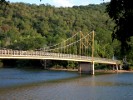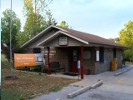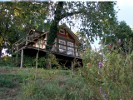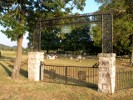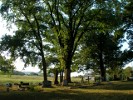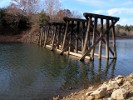Beaver, AR - Carroll County
"The Beaver homestead is on high and level ground overlooking and including a picturesque arc of White River, on the opposite banks of which, rising sheer from the water's edge, are the famous Cedar Cliffs. The dense green foliage of the graceful cedars appliqued upon the limestone bluffs of dazzling white, forms a picture of striking and perpetual beauty - the same in Winter and Summer." ~ Eureka Springs Newspaper, Oct. 21, 1901History of Beaver
The historic town of Beaver, Arkansas is named for Squire Wilson Ashbury Beaver, born June 7, 1831. Although Squire Beaver was a native of North Carolina, he had relocated to Tennessee with his parents in 1835 and at the age of twenty, he married Emeline Waits, a native of Alabama. Family history also suggests that Emeline was a half-sister to Judge L.B. Saunders, a very influential Carroll County settler who played a major role in the devlopment of both Berryville and Eureka Springs. In 1857, Squire and Emeline purchased roughly 348 acres of land on the banks of the White River in the Ozarks from John and Sarah Williams, who had acquired the land from the U.S Government. In that same year, the doomed Fancher Wagon Train passed through Beaver on their way to California. 120 members of their caravan would later be killed in Utah during the infamous Mountain Meadows Massacre. Other early homesteaders in the Beaver area included the families of Walden, Shelton, Gaskins, Lundy, Swope, Creed, Perkins, Wilson, Pyle, and Pyatt.
Beaver Spring
Like so many communities in Carroll County, much of the development around Beaver centered on a natural spring. Historic Beaver Spring was utilized by Native Americans long before white settlers arrived in the area and built a log structure to enclose it, using it as a water supply for several nearby homes. The log structure was later rebuilt with locally sourced stone and stands today near the Beaver suspension bridge and walking trail.
Beaver's Ferry and Beaver's Station
The Beaver Family soon built the Beaver Inn and established a ferry, and the location became known as "Beaver's Ferry". Squire was a staunch Democrat and served in the Confederate Army. His inn was frequently visited during the Civil War and in 1862 care was administered for wounded soldiers after the bloody Battle of Elkhorn Tavern (Pea Ridge). In fact, the Beaver Family's log home played such an active support role during the war that it was often referred to as the "Old Confederate House". It also housed the Beaver Post Office at one point. Squire Beaver's second wife was well known throughout the area for her unconditional hospitality and charity during hard times. It was said that "Mother Beaver", as she came to be known, would never turn down a hungry tramp or hobo from her door. Between his two marriages, Squire Beaver fathered 10 children. He also served as Justice of the Peace for many years.
An early general merchandise store was also established just north of town by a man named Pat Oliver, near the historic Walden homestead. The town of Beaver didn't actually become part of Carroll County until 1869. On September 22, 1879, the "Beaver Ferry" Post Office was established, with Squire Beaver serving as first postmaster. By March of 1880, the Beaver Ferry Post Office had closed, but a stagecoach line was utilizing "Beaver's Station" as an official stop-over. On October 3, 1881, the Post Office reopened and the name was shortened to just "Beaver". A stone quarry was established, employing some 400 laborers and supplying cross-grained cream colored magnesian limestone to such architectural treasures as the Crescent Hotel in Eureka Springs and the Sebastien County Courthouse. Later, a connecting line from the train station in Eureka Springs to Seligman, Missouri would also bring the railroad through "The Narrows" and into Beaver's Station. The railroad would run past Beaver until the 1950's, when the nearby Butler Creek bridge was compromised by a flood and a train was lost in the hollow. By 1960, the railroad was no more.
The Legacy of Cash Mark Swope
The Beaver Inn was later operated by a man named Cash Mark Swope (b.1870). Like his predecessor Squire Beaver, Swope was a veritable "jack of all trades", acting as the town merchant, postmaster, storekeeper, railway and express agent, boat rental agent, lumber dealer, and as a farmer dealing in produce, poultry, and meats. Swope also built a bath house, baseball park, and steam-powered boat launch. As proprietor of the Beaver Inn, he decided to relocate the building and he promptly changed the name to "Riverside Inn". It would later be known as the Stagecoach Inn. However, Swope's most lasting legacy for the town of Beaver would be the construction of a two-story general store and trading post in 1901. It has been restored and the historic stone building still stands today, serving as the Beaver Town Inn and General Store.
Of Bridges and Dams
Squire's original "Beaver Ferry" was eventually sold to a man named Mr. Wilson, and it operated until Carroll County decided to construct a toll bridge across the river in 1926. This early bridge was destroyed in a flood in 1943. The picturesque suspension "swing bridge" of Beaver Town, often referred to as the "Little Golden Gate Bridge of the Ozarks" is actually the third bridge built in that location. It was completed in 1949 to coincide with the construction of Table Rock Dam, and to replace a concrete bridge that had been washed out by frequent flooding. The town of Beaver was also incorporated on July 21, 1949.
In the 1950's the United States Corps of Engineers was considering building a dam on the White River near Beaver. Although the project was ultimately moved to a another location in Carroll County, the $60 million "Beaver Dam" project retained its name. Construction began in 1960 on a section of the White River near Busch, Arkansas, and "Beaver Lake" was formed in Benton and Carroll County. Table Rock Lake was also developed in 1958, altering the Clabbern River branch connection to the White River, and threatening to place the historic Beaver Family log home known as the "Old Confedrate House" beneath the lake.
In April of 1959, the Carroll County Historical Society contacted the Corps to alert them of the historical importance of the structure. Meeting on site in August, it was suggested that the "Beaver Club" would utilize the building as a clubhouse and gift shop. The building was also considered for a museum. The society would withdraw their application a year later, however, when the Corps informed them that admission fees could not be charged to maintain the structure. The Society also contacted Pea Ridge National Battlefield in 1962 and suggested that the building might be relocated and used as a battlefield museum, but by the end of the year Army engineers had already razed the structure. A special agreement with the Corps of Engineers would allow Beaver residents to maintain the shores of the lake in Beaver as a "Beaver Park" and campground. A walking trail was later developed along the old railroad bed.
Beaver was re-incorporated on November 28, 1980.
« Click here for sourcesCommunities of Carroll County:
|


